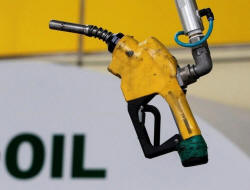|
Oil edges up on falling
U.S. crude stocks
 Send a link to a friend
Send a link to a friend
 [August 16, 2017]
By Henning Gloystein and Dmitry Zhdannikov [August 16, 2017]
By Henning Gloystein and Dmitry Zhdannikov
SINGAPORE/LONDON (Reuters) - Oil prices
edged up on Wednesday, lifted by declining U.S. crude inventories,
although markets were still restrained by excess supply.
Market focus was turning to the release of official U.S. Energy
Information Administration data later on Wednesday for a further update
on inventories.
Brent crude futures <LCOc1> were at $51.14 per barrel at 1010 GMT, up 34
cents, or 0.66 percent, from their last close.
U.S. West Texas Intermediate (WTI) crude futures <CLc1> were at $47.82 a
barrel, up 27 cents, or 0.56 percent.
U.S. crude inventories fell by 9.2 million barrels in the week to Aug.
11 to 469.2 million, industry group the American Petroleum Institute
said on Tuesday.
That compared with analyst expectations for a decrease of 3.1 million
barrels.
"The market took this as a mildly bullish report," said William
O'Loughlin of Australia's Rivkin Securities.

If the API data is confirmed by the U.S. government later on Wednesday
it would represent a seventh consecutive week of a decline in stocks,
one of the key metrics for OPEC and other oil producers which have
curtailed output to boost prices.
A dip in Libyan output due to security breaches at a major field was
also supporting Brent.
More broadly, analysts said ample supplies were preventing prices from
moving much higher.
"Excessive supply ... is continuing to weigh on oil prices ... Not a lot
has changed despite the OPEC and Russia efforts recently. While these
producers have tried to limit their oil output, U.S. shale oil continues
to rise," said Fawad Razaqzada, an analyst at futures brokerage
Forex.com.
[to top of second column] |

A gas pump is seen hanging from the ceiling at a petrol station in
Seoul June 27, 2011. REUTERS/Jo Yong-Hak/File Photo

The Organization of the Petroleum Exporting Countries together with
non-OPEC producers such as Russia have pledged to restrict output by 1.8
bpd between January this year and March 2018.
Offsetting much of that effort, however, U.S. oil production has soared
by almost 12 percent since mid-2016 to 9.42 million bpd.
"OPEC and Russia still face an uphill battle in reducing the global
supply surplus in the face of growth in output elsewhere and less than
compliant behavior in their midst (Iraq, UAE)," said French bank BNP
Paribas.
On the demand side, analysts see a gradual slowdown in fuel consumption
growth.
In the United States, energy consultancy Wood Mackenzie said gasoline
demand was already peaking due to improving fuel efficiency and the rise
of electric vehicles.
In China, state-owned China National Petroleum Corporation (CNPC) said
gasoline demand would likely peak around 2025 and outright oil
consumption would top out around 2030.
This means that oil demand from the world's two biggest consumers may
soon stall, while consumption has already peaked in Europe and Japan.
(Reporting by Henning Gloystein and Dmitry Zhdannikov; Editing by
Richard Pullin and David Evans)
[© 2017 Thomson Reuters. All rights
reserved.] Copyright 2017 Reuters. All rights reserved. This material may not be published,
broadcast, rewritten or redistributed. |